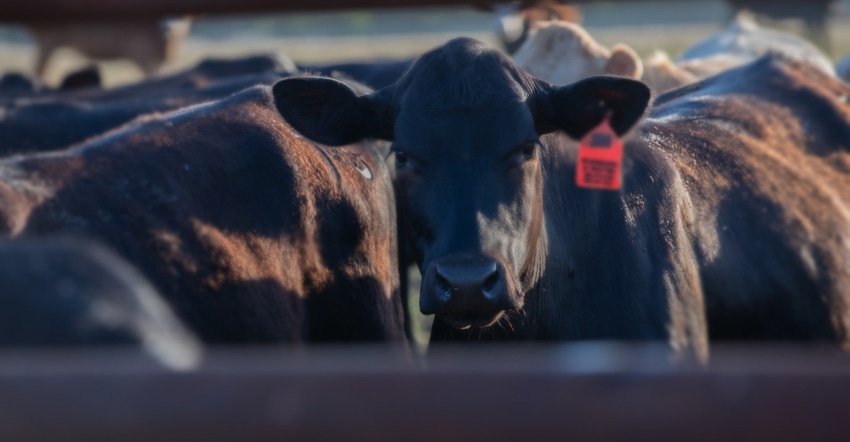Welcome to Health Ranch, where you can find information and resources to help you put the health and well-being of your cattle at the top of the priority list.
BRD is a serious condition for calves with big downsides for the beef industry. Find out what steps you can take to limit the impact of BRD in your herd.
September 4, 2019

Sponsored Content
Many cattle carry one or more of the bacterial agents associated with respiratory disease with no ill effects. However, under stress, their defense mechanisms may be suppressed, often resulting in one of the biggest health threats to a beef operation: bovine respiratory disease (BRD).
“There are a number of stressors that contribute to the onset of this disease complex,” said DL Step, DVM, Boehringer Ingelheim. “Weaning, shipping, weather fluctuations, changes in nutrition and commingling are just a few factors that can increase the likelihood of cattle becoming infected with BRD.”
Also known as pneumonia, or “shipping fever,” BRD is a serious condition for calves with big downsides for beef producers. In fact, it’s the No. 1 cause of mortality in weaned calves and generates an estimated $800 million to $900 million annually in economic losses from death, reduced feed efficiency and treatment costs.1
The majority of illnesses due to BRD occur within the first 45 days following weaning, placing on feed or shipping of cattle, making early diagnosis and administering appropriate treatments key in reducing the costs associated with this devastating disease.1
To improve calf performance and prevent production losses, Dr. Step encourages producers to implement an effective BRD diagnosis and treatment plan:
Consult your veterinarian to establish a unique case definition.
Creating a case definition for BRD that outlines abnormal clinical signs and behavior infected cattle may exhibit will help producers diagnose the disease quickly and respond with appropriate treatment.
“Cattle react differently to various stressors,” explained Dr. Step. “It is important to work with your veterinarian to estimate the level of risk for a particular group of cattle, apply the case definition, and develop a treatment protocol designed specifically for those animals.”
He recommends producers establish a case definition of BRD that lists signs, along with an appropriate temperature cutoff for their cattle. When a calf is exhibiting abnormal signs consistent with the case definition, they should be administered an antibiotic labeled for the treatment of BRD.
Monitor stressed animals closely.
“Early diagnosis of BRD is especially important,” said Dr. Step. “Check on at-risk cattle at least once per day, and watch for clinical signs such as depression, slow movement, weakness, difficulty breathing, decreased or absence of appetite, nasal discharge, droopy ears or arching of the back and stumbling.”
If not treated in a timely manner, cattle will have a poorer response to antibiotic treatment, potential relapses and a greater risk of mortality.2 By keeping a close eye on cattle, and using an established case definition to make appropriate treatment decisions, producers can catch BRD early on, and administer a fast-acting antibiotic to minimize lung damage and other long-lasting effects on performance.
Keep accurate treatment records.
Monitoring results will help ensure treatment protocols are effective. Work with your veterinarian to establish a post-treatment interval protocol in which clinical signs are closely monitored over a set amount of days before determining if re-treatment is necessary. A necropsy can confirm the clinical diagnosis of BRD and help determine the extent of the disease. In certain situations, a culture of the diseased lung can help determine the disease-causing pathogens affecting the cattle on your operation, and your veterinarian can help identify future treatment options.
Managing BRD is critical to maintaining a profitable herd, and it takes a mixture of well-implemented management practices to control it. “Every herd is different, so remember to consult a local veterinarian to develop the most effective BRD prevention, diagnosis and treatment protocols for your operation,” concluded Dr. Step.
References:
1 Brooks KR, Raper KC, Ward CE, et al. Economic effects of bovine respiratory disease on feedlot cattle during backgrounding and finishing phases. Oklahoma State University Agricultural Experiment Station, Division of Agricultural Sciences and Natural Resources. Pp. 1–10. Available at: http://pods.dasnr.okstate.edu/docushare/dsweb/Get/Document-6830/P-1027%20Economic%20Effect%20of%20BRD1.pdf. Accessed July 16, 2019.
2 Bagley CV. Bovine respiratory disease. In: Beef cattle handbook. University of Wisconsin-Extension, Cooperative Extension – Beef Cattle Resource Committee. Available at:
http://www.iowabeefcenter.org/bch/RespiratoryDisease.pdf. Accessed July 16, 2019.
©2019 Boehringer Ingelheim Animal Health USA Inc., Duluth, GA. All Rights Reserved. US-BOV-0093-2019a
About the Author(s)
You May Also Like
